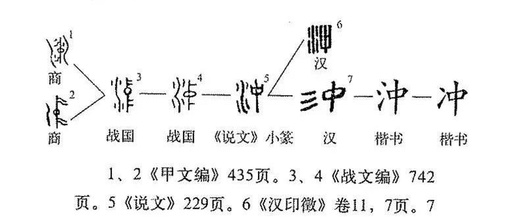“Chong Mai” and “Dai Mai” are named primarily based on their functions and circulation characteristics.
1. Chong Mai
1. The character “Chong” (冲) originally means:
The character “Chong” is depicted in oracle bone script as “water” (水) within the character “middle” (中), vividly representing the scene of flowing water. In oracle bone script, the sides of the character “Chong” are “water,” with “middle” in between, resembling a picture and functioning as a phonetic character. This structure reflects that the original meaning of “Chong” is the surging of water, indicating the flow and impact of water.
The form of the character “Chong” has undergone multiple evolutions throughout history. From oracle bone script to bronze inscriptions, and then to small seal script and clerical script, its form gradually simplified while retaining the basic structure of “water” and “middle.”
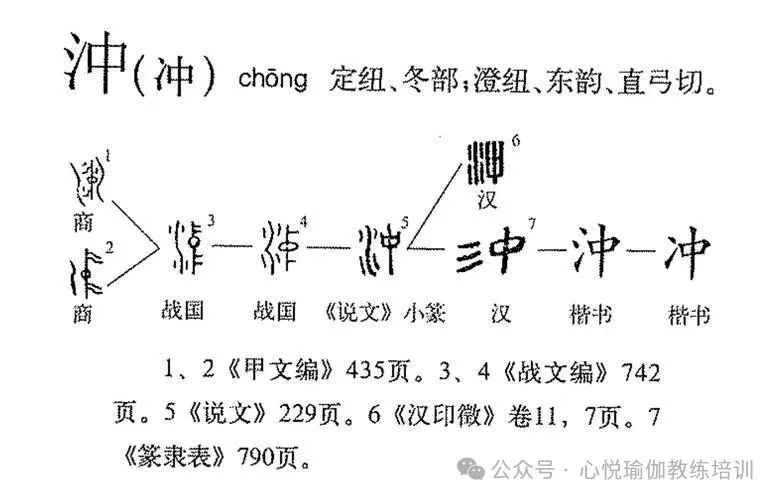 2.
2.
2. Extended meanings:
Impact and collision: Derived from the impact of flowing water, it extends to the forceful impact, as in “conflict” (冲突) and “charge” (冲锋).
Void: In Daoist philosophy, “Chong” implies “emptiness and tranquility.” Using “Chong” as a metaphor for the Dao emphasizes the wisdom of emptiness, harmony, and non-contention. In the “Dao De Jing”: “Great fullness is like emptiness, its use is inexhaustible.” Here, “Chong” refers to a state of emptiness and inclusiveness.
Traffic artery: It extends to mean “key junction” or “hub,” highlighting the importance of its position.
3. Naming
The rise and fall of Qi and blood in the Chong Mai directly affects women’s menstruation and reproductive functions (as mentioned in the “Huangdi Neijing”: “When the Chong Mai is abundant, menstruation occurs on time”). The classics of TCM refer to it as the “Sea of Blood,” emphasizing its role in regulating Qi and blood throughout the body, thus its “Chong” also implies “coordination of Ren and Chong.”
The Chong Mai, along with the Ren Mai and Du Mai, originates in the lower abdomen, ascending to the throat and descending to the feet, converging the innate kidney Qi and acquired spleen-stomach Qi, traversing the body from top to bottom, connecting multiple meridians, with branches distributed throughout the body, akin to the “main road” of Qi and blood circulation. This characteristic of traversing up and down makes it a “hub” for Qi and blood flow, hence the metaphor of “Chong” for its accessibility.
The naming of “Chong Mai” integrates its hub position, Qi and blood regulation function, and circulation characteristics, reflecting the TCM tradition of naming based on function.
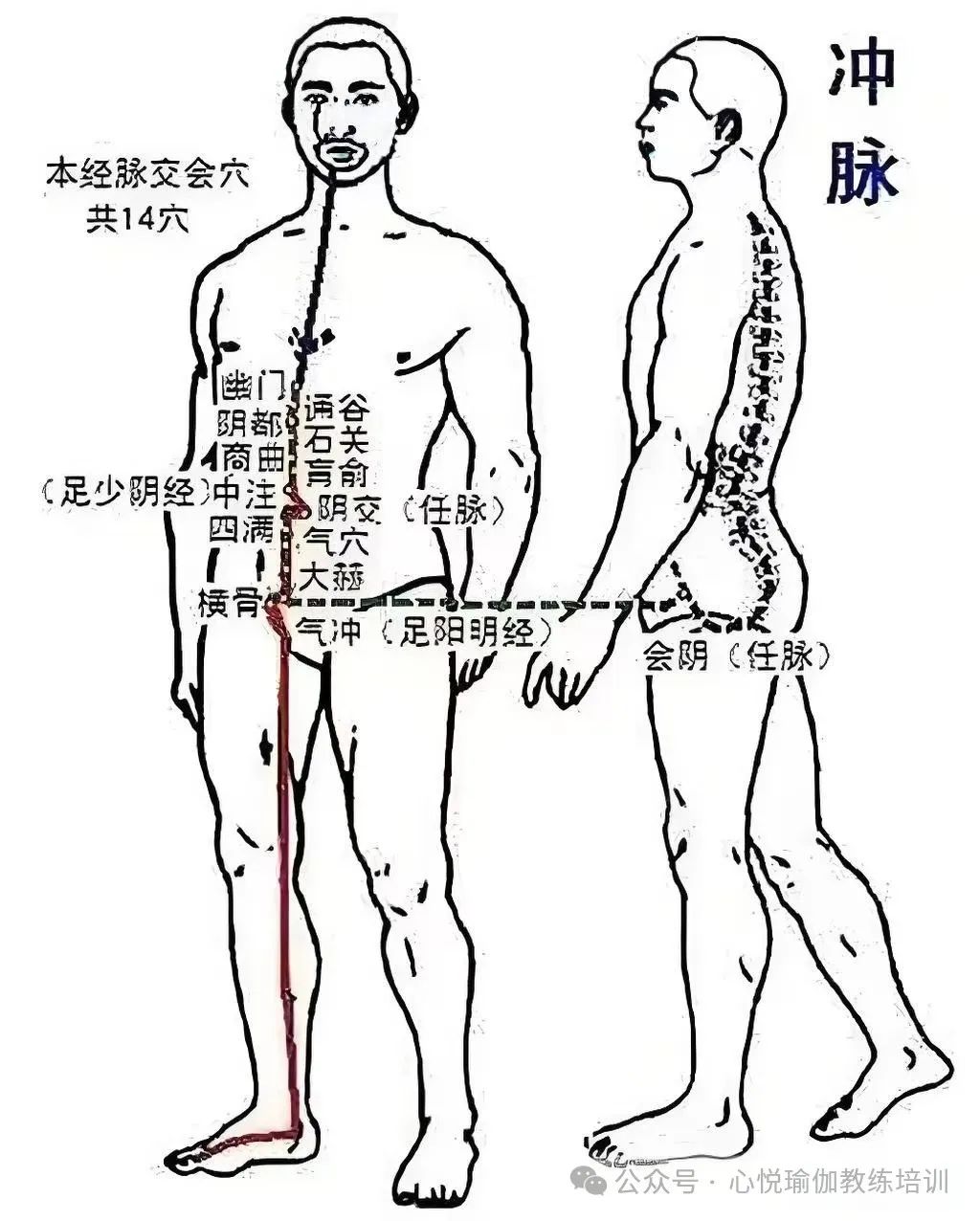
2. Dai Mai
1. The character “Dai” (带) originally means:
The “Shuowen Jiezi” explains “Dai” as:
“Dai, refers to a belt. Men’s belts are leather, women’s belts are silk. It symbolizes the shape of a tied ornament. An ornament must have a scarf, hence the character includes “scarf” (巾).”
(“Dai” refers to the belt used to bind clothing. Men use leather belts, and women use silk belts. The character’s shape resembles the form of an ornament, which must include a scarf, hence the inclusion of “scarf”.)
The oracle bone script for “Dai” is a pictogram, resembling a long belt with both ends drooping. The upper and lower parts of the character have tassels, and the middle is curved, vividly depicting the shape of a belt, reflecting the original meaning of “Dai,” which is the belt used by ancient people to tie their clothes.
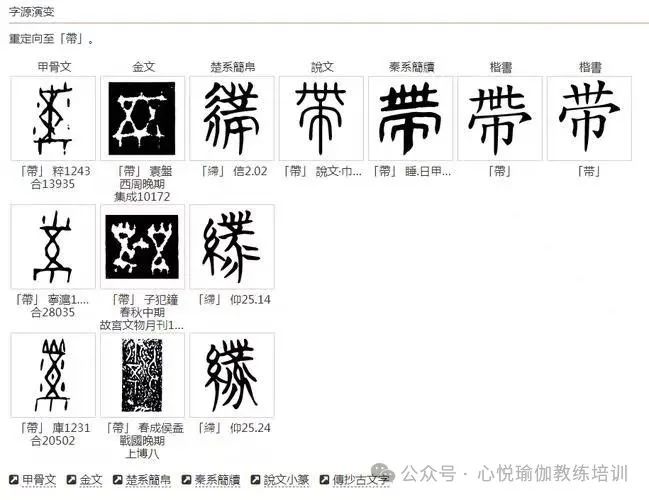
2. The evolution of the oracle bone script:
The upper part symbolizes the shape of a scarf or the knot of a belt.
The middle part: horizontal strokes represent the main body of the belt.
The lower part: hanging scarf or decorative items, reflecting the details of ancient clothing.
The oracle bone script for “Dai” has evolved from pictographic to ideographic. In oracle bone script, the upper and lower tassels symbolize the two ends of the belt, while the curved middle part represents the main body of the belt. Over time, the character’s form has gradually simplified but still retains the basic characteristics of the belt. The modern character “Dai” is based on the evolution from small seal script and clerical script, with the upper part inheriting the form of small seal script, while the simplified character returns to the form of oracle bone script.
3. Naming
In ancient Chinese, “Dai” refers to the belt used to bind the waist.
The naming of “Dai Mai” originates from its horizontal circulation around the waist like a belt. The Dai Mai is the only meridian that horizontally encircles the waist and abdomen, starting from the lateral abdomen (季胁), slanting down to the ilium, then wrapping around the waist and abdomen like a belt, horizontally constraining the vertical meridians of the body. This unique circulation pattern is the direct basis for its naming, with the belt symbolizing the earth’s support and constraint of all things, and the function of the Dai Mai subtly aligning with this imagery, reflecting the holistic view of TCM’s “correspondence between heaven and man.”
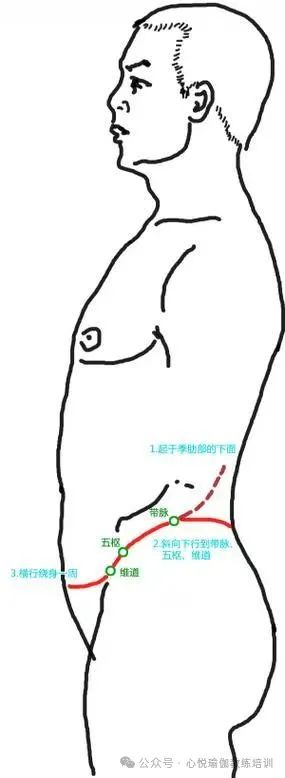
3. Yin Wei Mai and Yang Wei Mai
The names of Yin Wei Mai and Yang Wei Mai originate from the yin-yang theory in TCM meridian theory and their physiological functions. The naming of TCM meridians often combines function (e.g., “Ren” for nurturing, “Du” for governing), while Wei Mai focuses on the function of “linking” with the distinction of yin and yang.
1. Meaning of “Wei”
“Wei” means to connect and maintain: In ancient Chinese, “Wei” implies connection and maintaining balance. The functions of Yin Wei Mai and Yang Wei Mai are to maintain the coordination of Qi and blood in the body’s yin and yang meridians, connecting various meridians like a network to ensure yin-yang balance.
2. Yin Wei Mai and Yang Wei Mai
Yin Wei Mai: Originates from the inner side of the lower leg (intersecting with the Kidney Meridian of the Foot Shaoyin), ascends to connect with the Spleen Meridian, Liver Meridian, and other yin meridians (such as the Three Yin Meridians of the Foot and Hand), primarily regulating the Qi and blood of the yin meridians, related to the functions of internal organs (such as the heart, chest, and stomach).
Yang Wei Mai: Originates from the outer side of the heel (intersecting with the Bladder Meridian of the Foot Taiyang), ascends along the outer side of the lower limb, travels through the back of the trunk to the shoulder, and converges with the Du Mai. It connects with all yang meridians (such as the Three Yang Meridians of the Foot and Hand), primarily regulating the Qi and blood of the yang meridians, related to surface defenses (such as fever and headache).
3. Naming
Yin and Yang interdepend: Yin Wei and Yang Wei are mutually dependent, together maintaining the dynamic balance of Qi and blood, reflecting the core idea of TCM’s “yin-yang harmony.” The naming of Yin Wei Mai and Yang Wei Mai not only reflects their function of linking the yin and yang meridians but also embodies the wisdom of TCM in constructing physiological and pathological models of the human body through yin-yang classification. Their names represent a high integration of function and philosophical thinking, becoming an important hub for coordinating the internal and external balance in the meridian system.
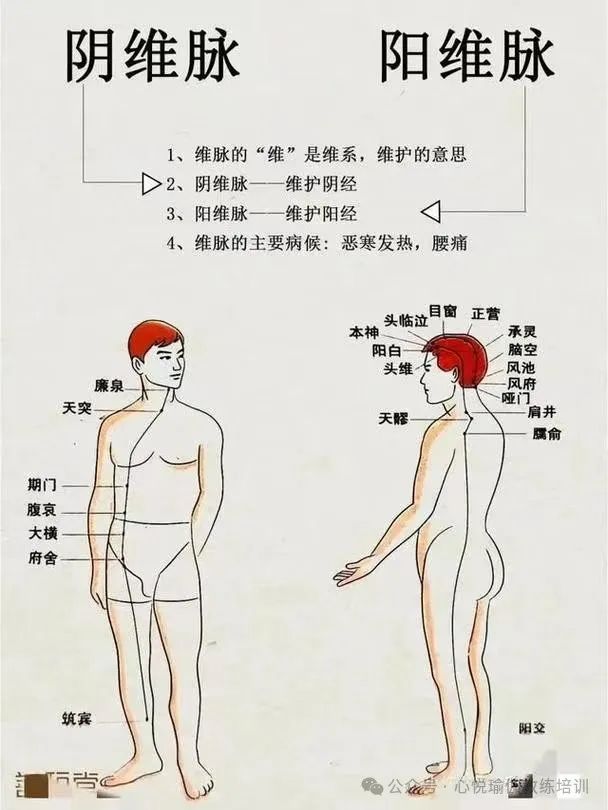
4. Yin Qiao Mai and Yang Qiao Mai
The names of Yin Qiao Mai and Yang Qiao Mai derive from TCM theory’s classification of meridian functions, circulation paths, and yin-yang attributes, distinguishing the opposing and unified properties of things through “yin and yang.”
1. Meaning of “Qiao” (跷)
In ancient Chinese, “Qiao” has two core meanings:
(1) To lift the foot lightly
“Shuowen Jiezi” explains “Qiao” as “to lift the foot and walk high,” meaning to lift the foot lightly. This is directly related to the function of the Qiao Mai in controlling lower limb movement, with both meridians coordinating foot actions and affecting walking ability.
(2) The extended meaning of “Qiao”
“Qiao” is interchangeable with “Qiao,” meaning “high” or “ascending,” subtly aligning with its circulation path from the feet upward to the head and face, regulating the overall Qi mechanism’s rise and fall.
2. Yin Qiao Mai and Yang Qiao Mai
Yin Qiao Mai: Circulates on the inner side of the lower limb, related to “yin Qi,” primarily nourishing the eyes, calming the spirit, and focusing on tranquility and nourishment.
Yang Qiao Mai: Circulates on the outer side of the lower limb, related to “yang Qi,” primarily controlling limb movement and alertness, focusing on activity and stimulation.
3. Naming
TCM naming often combines: position + function + attribute:
Yin/Yang: Positioning and functional attributes (static/dynamic, internal/external).
Qiao: Emphasizing its influence on lower limb movement and the rise and fall of Qi mechanism.
The combination of the two precisely summarizes the core characteristics of the meridians.
The names of Yin Qiao Mai and Yang Qiao Mai reflect both the philosophical thinking of TCM’s yin-yang classification and highlight their connection to lower limb movement and Qi regulation through the character “Qiao,” exemplifying the TCM theory of “unity of form and spirit” and “using images to illustrate principles.”
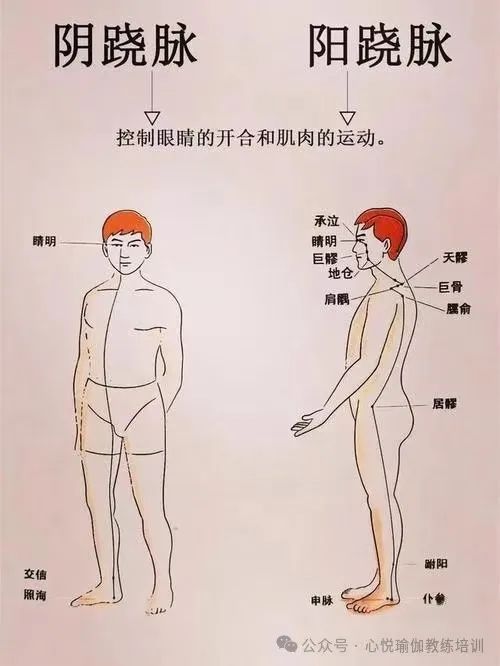
The twelve meridians, the flow of the twelve meridians, and health preservation.
Ren and Du Meridians ~ Ren Mai
Ren and Du Meridians ~ Du Mai: The “governor” of Yang Qi in the human body – circulation, acupoints, and health preservation.
Extraordinary Meridians ~ Chong Mai: The hub of life energy.
Extraordinary Meridians ~ Dai Mai: The “belt” of human health and health preservation hub.
Exploring the Origins of the Eight Extraordinary Meridians: The Naming of Ren and Du Meridians.

